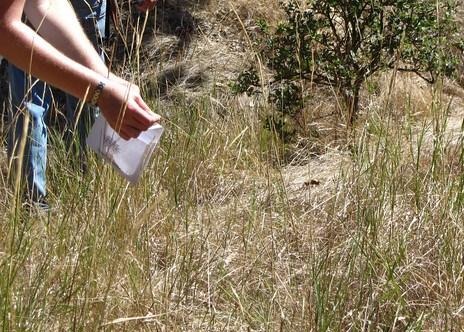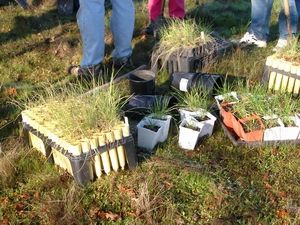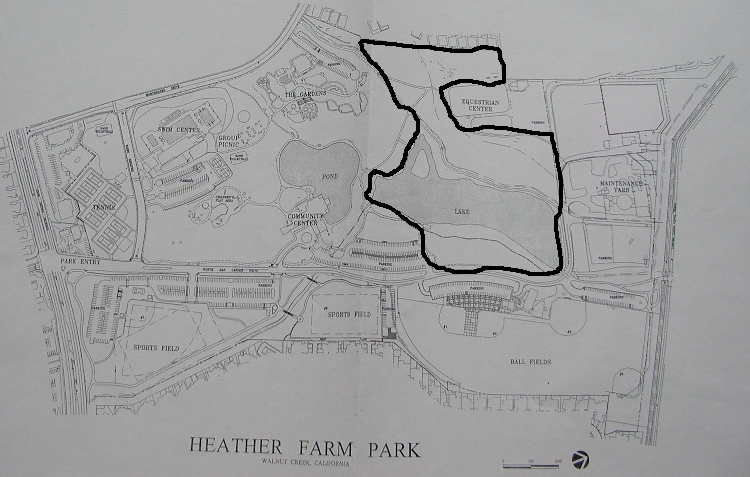Heather Farm Nature Area Restoration - 2002 to 2004
History
In spring of 2002 the Walnut Creek Park, Recreation and Open Space (PROS) Commission authorized creation of a task force to identify requirements for restoring the natural lake and three nearby areas in the Park. The task force initially included 3 members of the PROS Commission, 3 members representing the Mount Diablo Audubon Society, 2 members representing the Walnut Creek Open Space Foundation, 2 members from the Gardens at Heather Farm, 2 members from the Lindsay Museum and 2 members from the City of Walnut Creek staff. Task force members have been active in defining the restoration project and are a nucleus for implementing the restoration.The project was formally adopted as a Foundation project. Foundation members were active in all task force activities. In 2003, the Foundation received a grant from the Contra Costa Fish and Wildlife Committee and a Civic Pride Grant from the City of Walnut Creek to pay for this work.
Defining the Project
The task force first discussed the goals for the restoration and produced a report for the City of Walnut Creek. This report described the state of the nature areas, recommended improvements that would make the nature areas better habitat for plants and animals and a more interesting place for park visitors, and provided a road map for implementing the plans using community volunteers. Once this work was done, the task force withered away over the next couple of years, leaving the Foundation in sole charge.Heather Farm Habitat Report 2003[PDF]

Mowing down the weeds in Heather Farm
Site Preparation and Inventory
We surveyed the nature areas to determine what trees, shrubs and small plants were already present. Audubon chapter members produced a list of birds seen in the park.Since there were indications that high levels of boron or other minerals might be present, we took 20 soil samples and had them analyzed. We found low nitrogen but no boron.
Beginning in May 2002, we suppressed the spread of weeds such as mustard and several thistle species by mowing and hand pulling to reduce the level of weed infestation in areas where it was a significant problem (about 1/3 of the total nature area).
Bob Wisecarver identified the need for more perching places in the lake and developed a method to anchor log segments in the water. These new perches proved popular with birds and turtles.
Seed Collection

Collecting native grasses in Shell Ridge
We located stands of native grasses (purple needlegrass nasella pulchra and foothill needlegrass nasella lepida) and several species of wildflowers and shrubs in the Walnut Creek Open Space in the spring and monitored the development of seed in those stands. As seed matured, volunteers harvested it.

Grass ready for planting!
Propagating Plants
Starting in August 2003, volunteers propagated seed and cuttings at the lath house operated by the Gardens at Heather Farm. This activity continued until the end of October with regular weekly sessions. The Garden's staff provided effective training for project volunteers and we were able to use their greenhouse facilities to get our plants off to a good start.As plants grew, we moved them to larger containers. This was a more time-consuming effort but we were able to accomplish it with weekly sessions using small groups of volunteers in October. We produced over 1100 native grass plants ready to be planted in the park's nature areas in January. We also raised about 300 wildflowers.
Our germination rate for grass and flower seed was quite high. Most propagation sessions resulted in one or more seedlings in over 95% of cells planted. The purple needle grass plants (nasella pulchra) thrived as did Clarkia and red bugler penstemon. Some predation by unknown animals occurred especially on foothill penstemon in the greenhouse. Some plants were left in the very moist greenhouse environment for too long. We learned lessons for next year's effort. Overall, the process went smoothly with a higher level of success than anticipated.
Planting in 2003

Drilling holes to plant the grass plugs in.
Our productivity of 40 to 50 plants per person was much higher than the 10 to 20 plants we had expected. We had no trouble getting our remaining stock of about 600 grass plants in the ground in January.
From late spring through mid-summer of 2004, we watered the seedlings to give them a better survival rate in their first year. After that, their roots would be deep enough to make it on their own.
Construction
The Rotary Club of Walnut Creek adopted construction of facilities in the nature area as their centennial year (2004) project. They constructed two kiosks that we and the City Staff will use to educate the public about the nature areas in the park. Our project paid for the kiosk materials. Next they built observation platforms at the edge of the lake. Finally, they built a pedestrian bridge to provide public access to the main nature area. This eventually took five years because multiple government agency approvals were required.Volunteers from 2004 Week of Caring helping to propogate plants for Heather Farm
Planting in 2004
In summer of 2004, the City of Walnut Creek funded two projects to support our restoration work. Sycamore Associates produced recommendations for the project including plant lists for grassland, woodland, riparian and chaparral habitat areas. Architect Karen McArdle created a map showing trails and habitat areas.We again collected seed from the Walnut Creek Open Space in spring and summer of 2004. Volunteers from Chevron and Wells Fargo helped us propagate seedlings during the Week of Caring organized by the Volunteer Center of Contra Costa. Students from several local schools have also participated in propagating bunchgrass seed. We streamlined our methods to eliminate transplanting the seedlings.
We planted these bunchgrass seedlings in December 2004 and January 2005 with help from volunteers.
Planting in Subsequent Years
Over the next several years we planted ever-larger numbers of grass seedlings mainly with high school volunteers. However, we didn't have enough skilled labor to weed the grass in the spring. Eventually the weeds overwhelmed the grass and we lost a lot of it. Experimentation on other Foundation projects developed better methods. Experience gave us a better eye for the easiest places to convert to natives. Economic conditions since 2008 dried up our principal source of high school volunteers. Since then we have continued the project on a smaller scale.The Natural Lake
Towing a newly-planted floating island to its anchor point in the lake
We have done several things to enhance the lake's habitat values. The turtle basking logs we installed early in the project have been well used. In 2012, volunteers put up wood duck boxes to encourage this shy but very attractive, cavity-nesting species to colonize the park.
There has been a long-standing problem with algae blooms in both the natural lake and the cement-lined pond, made worse over the years by our increasing population of Canada geese. Staff installed two floating islands in the cement pond in August 2012 to process the nitrates. Water quality will be tested quarterly so we'll have data. We are all hoping this will solve the algae problem and improve habitat for the fish. If it works, we will raise money to install islands in the natural lake.
A great egret and an otter using the floating island in December, 2013
We have not worked intensively on this project in the past couple of years, but we continue our traditional Martin Luther King planting day. In 2015 we added some native grass and soap root so we would have some flowers.
Bill & Lesley Hunt




 Join/Renew
Join/Renew Donate
Donate Volunteer
Volunteer Maps
Maps Newsletter
Newsletter Facebook
Facebook

